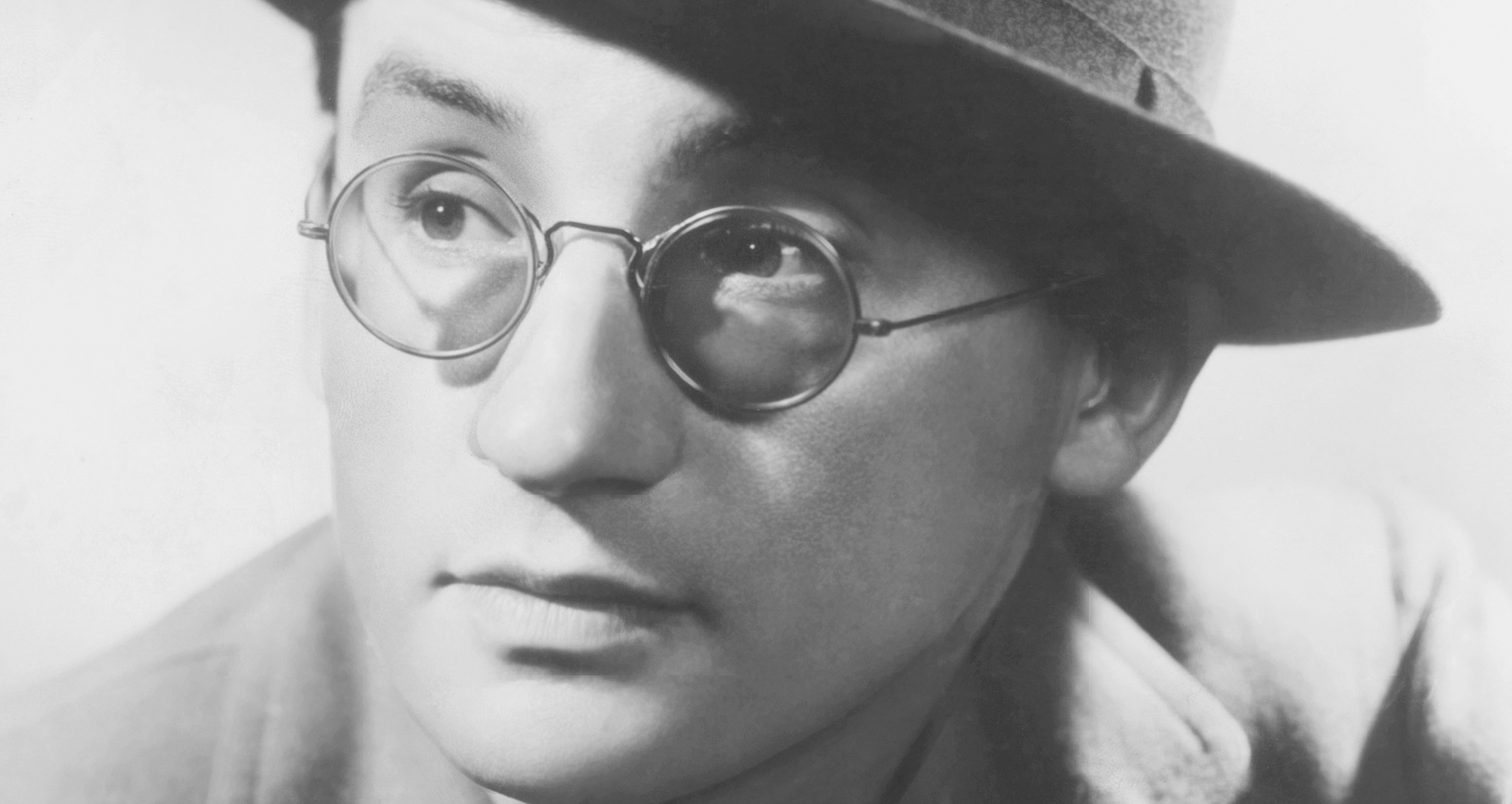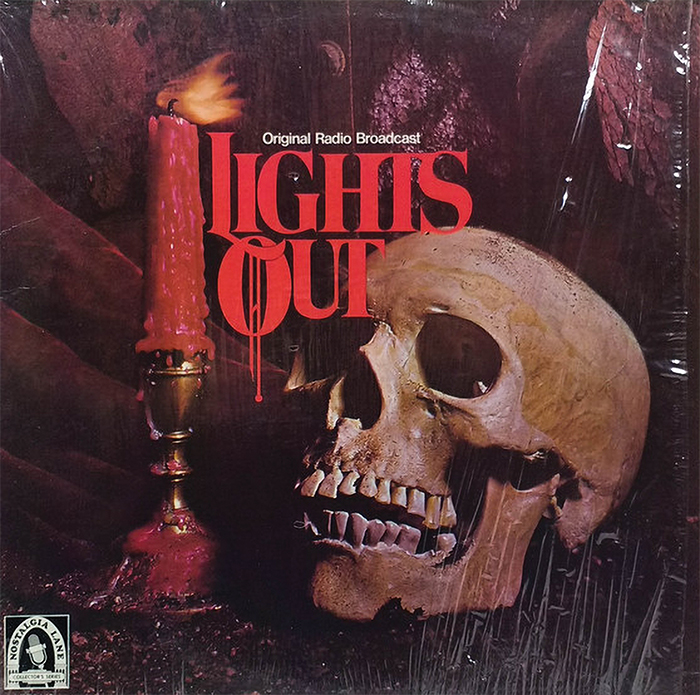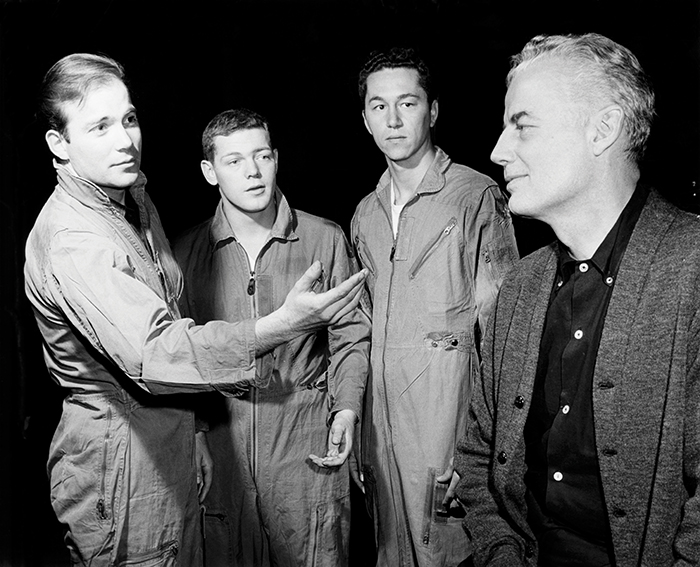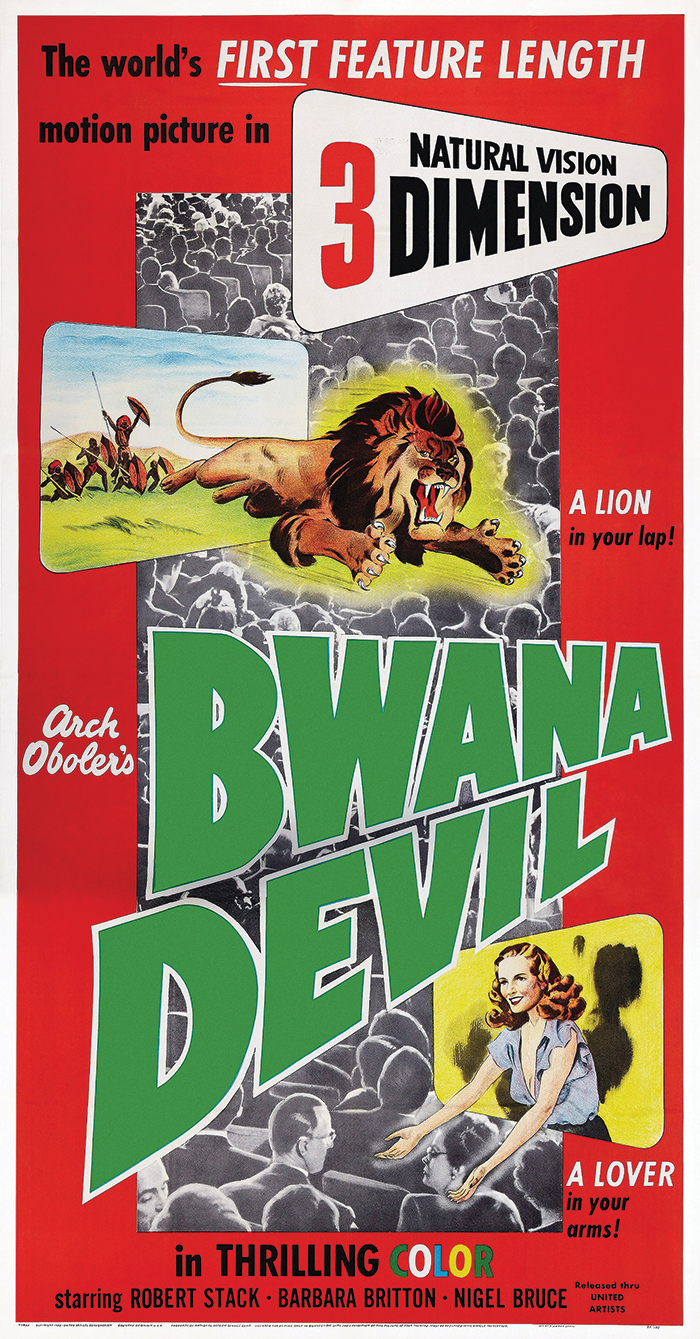
Arch Oboler, EX’36—a fiction writer, radio dramatist, and filmmaker—has largely been forgotten, but from the 1930s through the ’50s he was a household name. (Everett Collection)
Radio dramatist Arch Oboler, EX’36, shone a light on the horrors of humanity—in fiction and in reality.
It’s 1943. Bernice and Mary are working overtime typing an episode of Lights Out, an NBC radio program that Mary describes as full of “blood and people dying and murderers and worms.”
Bernice: “I wonder what kind of a screwball he is … the fellow who writes these plays.”
Mary: “Arch Oboler?”
Bernice: “Personally, I think he’s a wolf … one of these werewolves.”
As the night progresses, the lights go out, one by one. Typewriter keys clack chaotically; desks move; one remaining light turns green. The women descend into fear and psychosis, ending with their demise—ostensibly scared to death.
Bernice and Mary are the primary characters in “Murder in the Script Department,” one of Arch Oboler’s self-referential episodes of Lights Out, a weekly half-hour show with millions of listeners despite its midnight airtime.
Oboler—a fiction writer, radio dramatist, and filmmaker—has largely been forgotten, but from the 1930s through the ’50s he was a household name. A technical innovator, he experimented with novel sound effects and 3D film. And as an entertainer with his finger on the pulse of shifting mores, he depicted the horror he saw in humanity. His platform and message made Oboler one of the earliest, most prominent American voices condemning fascism.
He wrote drama, comedy, and polemics, but it was Oboler’s “weird fiction”—speculative storytelling blending fantasy, science fiction, and horror—that made him famous during radio’s golden age. Supernatural or suspenseful shows were wildly popular. One of the programs that kindled the trend was Lights Out, the brainchild of writer-director-producer Wyllis Cooper, launched in 1934 and broadcast on NBC-affiliate WENR in Chicago. Cooper innovated the use of macabre narratives and eerie sound effects, but most of his plays have been lost.
When Cooper left for Hollywood in 1936, the network tapped Oboler, EX’36, a young NBC playwright, as his successor. Under Oboler’s direction, Lights Out ran another three years, took a hiatus, and returned in 1942 for one season. The show was syndicated during a nostalgic radio boom in the 1970s as The Devil and Mr. O. (As many episodes were lost, recreated, or recycled, the provenance of archived recordings is frequently disputed.)
The program opens with a warning: “It … is … later … than … you … think. … If you frighten easily, turn off your radio now.’’
The exception was a 1943 episode condemning the Third Reich: “We urge you to turn your radios up and listen as you never did before.”

(Super)naturalist
Born in Chicago in 1907 to Jewish immigrants from Latvia, Oboler was a prodigious writer. A 1942 profile in the Sentinel, a Jewish weekly, painted Arch as a naturalist-in-training who collected a veritable zoo of animals and insects. Inspired by his menagerie, he sold his first story at age 10 to the Chicago Daily News. It was about an amorous dinosaur.
At Hyde Park High, he served as president of the Stone Age geology club. In Oboler Omnibus: Radio Plays and Personalities (Leisure Books, 1971), a collection of plays interspersed with autobiographical reflections, he describes an early ambition to become a paleontologist and find a living descendant of the plesiosaurus. As a teenager Oboler developed a passion for radio, building a receiver by winding wire around an oatmeal box, which led to an interest in electrical engineering. He considered writing a hobby.
Oboler enrolled at Chicago in 1926 but left after a couple of years. Accounts differ: some report he left voluntarily to write; others claim he was expelled. (Notably, in 1936, the year he began writing Lights Out, he returned for a course in psychology.)
In 1933 Oboler wrote his first radio play: a science fiction drama, Futuristics, that satirized the present by casting it as the past as viewed from the future. The script was bought by NBC and proved hugely successful, earning Oboler an opportunity to write for Grand Hotel and The Irene Rich Show.
He also contributed to variety shows including the Royal Gelatin Hour (programs were often named for sponsors). “Soon I was pleading for the opportunity to do a weekly half-hour series of original plays written not for yeast, or soap, or hand lotion,” Oboler said, “but idea plays written for the radio medium.”
That opportunity arose when Oboler inherited Lights Out. While still beholden to sponsors—frequently Ironized Yeast (fight the Gray Sickness of iron deficiency!)—the show’s late-night airtime bred apathy from advertisers.
Oboler made Lights Out his own in craft and content. His plays feature killers (“Murder Castle”), ghosts (“Poltergeist”), animal transformations (“Cat Wife”), and yes, worms (“Revolt of the Worms”). He also made monsters hatched from human faults: anger (“Valse Triste”), susceptibility (“Kill”), and ambition (“Chicken Heart”). He excelled at manifesting the evils and fears of human interiority. His debut, “Burial Services,” featured a paralyzed girl who is buried alive. NBC purportedly received 50,000 protest letters.
In response, Oboler escalated the fantastical, but maintained the worst horrors are in and of human nature. At the end of “Kill,” in which a man is driven to murder by a sleep-borne demon, Oboler offered a moral: “The evil that men do may be caused by outside influences—poverty, the will to power, the wrongful examples of others—but as to evil being a living monster, well supposing we call tonight’s story a parable of a man who really wanted to kill and saw the evil intent within himself personalized so vividly that he thought it actually existed outside of himself.”

Disembodiment of fear
Legendary horror actor Boris Karloff, who starred in several Lights Out episodes, told Radio Stars magazine in 1936, “All sheerest horror is in sound.” Radio is best suited for terror: “the Unseen, the ghastly scream out of Nowhere, the cry in the dark … if we do not know through our eyes what bodies these sounds wear, we are helpless and … a thousand times more terrified.”
Oboler harnessed those unbodied fears, writes novelist and spiritual descendent Stephen King in Danse Macabre (Everest House Publishers, 1981), a meditation on the horror genre. King writes that Oboler “utilized two of radio’s great strengths: the first in the mind’s innate obedience, its willingness to try to see whatever someone suggests it see, no matter how absurd; the second is the fact that fear and horror are blinding emotions that knock our adult pins from beneath us and leave us groping in the dark like children who cannot find the light switch.”
When radio drama first emerged, writers thought about it in relationship to the stage, says Neil Verma, AM’04, PhD’08, author of Theater of the Mind: Imagination, Aesthetics, and American Radio Drama (UChicago Press, 2012). The goal was to find a quality that would make radio “fundamentally different,” says Verma. The obvious difference is radio’s lack of visuals. (See “Aural Traditions.”)
So radio dramatists used sound cues to design a stage in the mind, with four implements: voice, for information and plot; music, for mood; sound effects, for movement; and silence.
Oboler was a sound effect innovator. His most famous technique appears in “The Dark,” in which a doctor and police officer respond to a call for help. They arrive at a house to discover a cackling woman, a man’s body turned inside out, and smoke filling the room. The smoke engulfs the characters and inverts their bodies. Oboler simulates the sound by pulling a wet rubber glove inside out.
The method is famous for its originality and as a result of Oboler’s self-promotion: he enjoyed talking about his tricks. The play Bernice and Mary are typing in the “haunted” script room is, in fact, “The Dark,” and a note to the sound department suggests using a wet rubber glove. (For a visual interpretation of the deadly smoke, including a similar sound effect, see the end credits for The Simpsons’ “Treehouse of Horror V” Halloween special.)
“There’s a kind of a psychological depth to sound effect usage that can’t be achieved with music or words,” says Verma. (See “Sound Foundations.”) Yet Oboler accented voice as well. Some of the most unnerving moments in Oboler’s Lights Out plays are vocals: the ubiquitous terrified screams, hysterical laughter, quiet gasps, death rattles.
One of Oboler’s most famous plays, “Chicken Heart,” uses both vocals and sound to disturbing effect. Originally aired during the show’s first stretch but lost, the story reappears on his 1962 album, Drop Dead! An Exercise in Horror! (Capitol Records). It tells the tale of the eponymous chicken heart, kept alive by scientists, that grows until it consumes the world.
Throughout the play, a heartbeat thumps, sirens scream, and propeller blades whirr as a doctor and pilot attempt to escape. Calm and resigned, the doctor describes the world ending while the pilot descends into panic. The premise is ridiculous, admits Verma, but there’s something “deep happening with this play, and it’s hard to put your finger on it.” One element that contributes to that indescribable response is the reaction of the crowd. The growing heart may not be believable, but the panic, fear, and anger of the populace are.
Oboler was inspired to write “Chicken Heart” in 1937 after reading about French surgeon Alexis Carrel, considered the father of transplant surgery. Carrel kept a sample of chick embryo heart tissue alive and dividing from 1912 through 1946, revolutionizing tissue culture by developing a cell propagation method called passaging. His experiment implied that biological cells were intrinsically immortal.
The notion of science-forced immortality struck Oboler as monstrous: thus, chicken heart obliteration. He did not know that Carrel’s experiment was the result of either negligence or fraud. It has since been established that ordinary cells have a preprogrammed number of divisions before cell death. (Cancer and stem cells play by different rules.)
What seems prescient is Oboler’s sense of science’s potential harm to humanity. Carrel was a self-proclaimed eugenicist and suspected Nazi sympathizer. In 1940 he formed an institute devoted to curing what he deemed the weaknesses of the human race.

War at home and abroad
In 1936 Oboler wrote a Lights Out episode, “Nobody Died,” about a cancer researcher somewhere in Europe who discovers a treatment that reverses aging. A fictionalized version of Nazi propaganda minister Joseph Goebbels, dreaming of creating an invincible army, executes the doctor to obtain the concoction. He takes the serum for eternal youth himself but reverts to infancy.
The story is a parable about the dangers of using science to subvert nature, writes Richard Hand in Terror on the Air! Horror Radio in America, 1931–1952 (McFarland & Company, 2006). “But it is also a political parable about fascism’s abuse of science for imperialistic and militaristic ends, concluding with the implied moral that the greed and aspiration of fascism will lead it to its own annihilation.”
In 1938, following a four-month stay in Europe, Oboler returned home with a galvanized hatred for fascism and a determination to use radio to defeat it. “I found myself wanting the dimensions of that half hour on the air expanded to take in the actual horror of a world facing, with half-shut eyes, the fascistic Frankenstein’s monster moving over Europe.”
He recorded a pilot for an experimental radio series, leading to Arch Oboler’s Plays, which was supported by NBC and free from sponsors. Oboler had complete creative control. “Nobody Died” was rebroadcast in 1939 as part of this series, which ran for a year.
Oboler was writing antifascist plays before there was an Office of War Information to sponsor anti-Nazi propaganda, notes Verma. The United States was mostly isolationist before Pearl Harbor; critics accused Oboler of being “prematurely antifascist.” Verma adds, “I think his sense of the incredible horror of what was happening in Europe at the time was pretty personal.”
After America entered World War II, Oboler devoted his writing to destroying totalitarianism. He created the radio series Plays for Americans, for which he took no payment. The first episode, “Johnny Quinn, U. S. N.,” about an American who died at Pearl Harbor, was named outstanding dramatic broadcast of the year by the Institute for Education by Radio.
Oboler was asked to speak at the institute’s meeting, where he was enraged after three days of his peers chasing “academic tails.” His speech reflected that anger: “I said that we at home needed a little of this hatred of evil in us; with nothing but defeat after defeat behind us at this point in the war, and with the certainty of sudden death ahead for thousands of our men, too many of us back here at home were concerned only with ‘getting the war over with by any means.’ … The time had come for us to begin to hate a little.”
The press responded with “cries that I was advocating a foul way of thinking,” said Oboler. Plays for Americans was promptly cancelled, after less than six months. Oboler had by then depleted his savings—but fortunately for him, interest in horror tends to spike in times of turmoil, and Lights Out was resurrected.
In cooperation with the Office of War Information and the Hollywood Victory Committee, Oboler created his To the President plays. Later came his series Everything for the Boys, sponsored by spark plug manufacturer Autolite. Over the course of the war, he produced more than 70 “beat the Axis” radio plays.

Off the air
While producing Arch Oboler’s Plays in the late ’30s, Oboler was invited to Hollywood to adapt for the screen one of the earliest anti-Nazi novels, Escape by Ethel Vance (Little, Brown, 1939). He and his wife, Eleanor, relocated to Los Angeles, bringing his radio series with them. Oboler commissioned a residence, near Malibu, California, from his friend Frank Lloyd Wright, named Eaglefeather—never completed and now called The Arch Oboler Complex.
Arch and Eleanor had four sons while living there, and the home went through fits and starts of construction, in tandem with Oboler’s financial fluctuations. This perpetual state of incompletion led to tragedy: In 1958 the Obolers’ six-year-old son Peter fell into a 14-foot-deep excavation filled with rainwater and drowned. (Oboler lived there until his death, and in 2018 the home was consumed by the Woolsey wildfire.)
During this period Oboler transitioned to filmmaking. In 1951 he wrote, directed, and produced Five, the first known film to depict a world after atomic annihilation, with five humans left on Earth. He shot the movie at Eaglefeather.
In the 1980s, horror director Joe Dante attended a screening of Five at which Oboler spoke. It was paired with another Oboler film: The Twonky (1953), a comedy about a possessed television set. The impatient crowd laughed at Five’s serious themes, and Dante remembers Oboler speaking to the audience afterward with such anger, “he was nearly in tears.” One of the film’s villains was a “vaguely Aryan heavy,” and “the director accused the audience of indifference to Nazi-ism.”
Oboler never achieved the critical success he enjoyed as a radio dramatist, but “cinema scholars find his films really remarkable and noteworthy,” says Verma. Between Five and The Twonky, he released Bwana Devil, the first 3D feature-length film. It was the fictionalized story of the 1898 Tsavo lion attacks, and the movie poster promised “a lion in your lap!” As with radio, Oboler was a keen innovator.
All told, Oboler has a couple dozen film and television credits to his name. He wrote a stage play, Night of the Auk (1956), envisioning the return trip from the first moon landing. It was a Broadway flop but was adapted for TV in 1960, starring a pre–Star Trek William Shatner. He published one novel, House on Fire (1969), to lukewarm reviews.
In his quasi-memoir, Oboler describes his final Lights Out episode, “The Author and the Thing.” In a mise en abyme story, Oboler plays himself writing his final Lights Out episode, which features an author (also Oboler) writing a play about a creature that comes to life. The monster transcends the layers, killing Oboler twice, “murdering myself off so completely, within the frame of the play, that the series, so far as I was concerned, could never be resurrected.” In 1987, though, just months before he died, Oboler sold the rights to rebroadcast surviving Lights Out episodes—setting the stage for one final resurrection.
